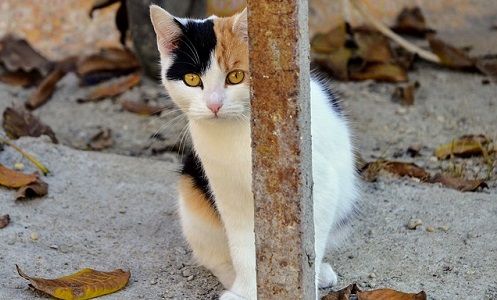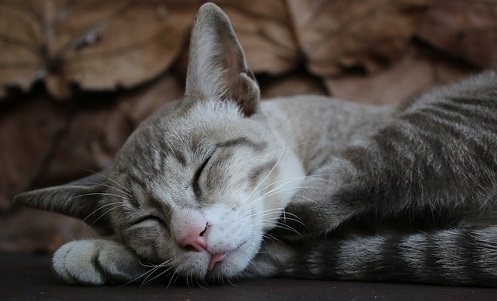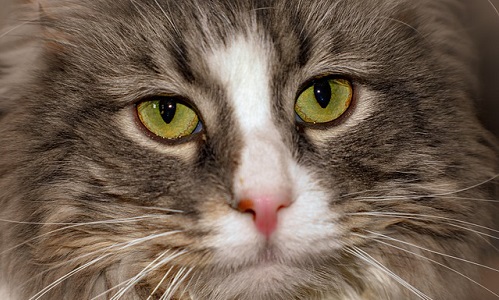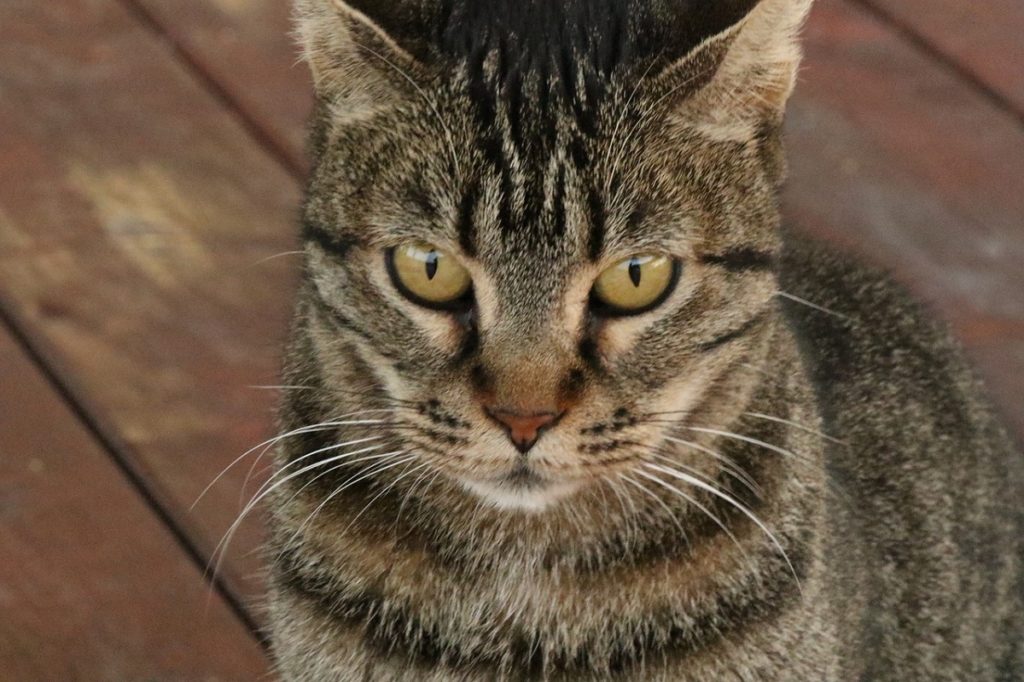Does your cat seem to be constantly sneezing or itchy all day? While this can be caused by a variety of conditions, it may also point to an allergy. A cat allergic to food will often show many of the same symptoms as their human counterparts who also suffer from an allergy.
Just like humans, dogs, and other species, cats can develop dozens of different allergies. This post is going to cover one of the most common types: food allergies in cats. In fact, food ranks as the third most common allergy in cats and dogs, accounting for about 10 percent of all allergies in the spectrum, right after flea bites and allergies caused by inhalants (pollen, etc.)
But despite environmental allergies being much more common, food allergies in cats are far more difficult for veterinarians to diagnose and treat, mainly due to the fact that there is no quick and accurate way to diagnose a food allergy. Very little is known about the food allergy process and the complicated antibody response in the intestinal tract that leads to an allergy. However, there is still much that we do know about food allergies, including what foods commonly cause allergies, the common symptoms, how to diagnose these food allergies (the process is known and proven, it just takes a while), and treatment options.
This post is going to go through all of these and more to give you a complete understanding of what to look for and what to do if you suspect your cat is allergic to food. Let’s get started by looking at the possible causes of food allergies in cats.
What Causes Food Allergies in Cats?
Unfortunately, finding the cause of your cat’s food allergy can be a tricky endeavor. This is especially true because it can take months or even years before your cat will develop an allergic response to a specific food. Oddly enough, the cat will typically develop an allergy to a food that he is commonly fed. But why?
Cats will become allergic to a particular food when their immune system misidentifies a protein in the food as a hostile invader and attacks it. Most commonly, food allergies and food intolerance in cats are caused by meats like beef, fish, lamb, and dairy products.
Cats develop negative reactions to certain foods because of the proteins involved with the food. This is typically related to meat products, but the problem proteins can be found in vegetables and other food products as well. Soy, corn, and gluten are also known to cause allergic reactions in cats.
Other common allergens in food that may cause a reaction in your cat includes artificial coloring used in foods to increase shelf appeal, corn products like cornmeal that are commonly used as inexpensive fillers in cat foods, dairy products (cats are actually lactose intolerant), meat by-products, and preservatives.
Unfortunately, these common allergy triggers are some of the most common ingredients found in cat foods. This isn’t a coincidence, as the proteins that cause allergic reactions are similar in form and the reactions are likely tied to the amount of exposure a cat has to a certain product.
Food allergies can also be caused by damage to the cat’s digestive system that results from canine inflammation, bacteria infection, dog surgery, and even reactions to some medications. Food allergies can occur at any age in felines although they are most commonly seen in cats between the ages of two and six. Certain breeds, including Siamese cats, seem to be more likely to develop an allergy than others but there is no strong genetic link.
Food Allergies vs. Food Intolerance
 While we’re on the subject, a distinction must be made between a food allergy and a food intolerance. A food allergy is a true allergy that will show all of the characteristic itching and feline skin conditions that are associated with allergic reactions. A food intolerance, however, is more similar to experiencing an upset stomach or diarrhea from eating a contaminated food. Food intolerances do not create the typical allergic reaction.
While we’re on the subject, a distinction must be made between a food allergy and a food intolerance. A food allergy is a true allergy that will show all of the characteristic itching and feline skin conditions that are associated with allergic reactions. A food intolerance, however, is more similar to experiencing an upset stomach or diarrhea from eating a contaminated food. Food intolerances do not create the typical allergic reaction.
Thankfully, both food allergies and food intolerance can be avoided with a carefully crafted diet. This diet will need to be resumed for the rest of the cat’s life, as they will be allergic or intolerant to the certain foods forever.
Symptoms of Food Allergies in Cats
It can be difficult to differentiate between an animal who has food allergies from one who has atopy or another environmental allergy. But there are some signs more associated with food allergies that may help you and your veterinarian make an accurate diagnosis.
Firstly, if your cat is suffering from allergies year-round rather than seasonally, or if symptoms first appear during winter, a food allergy is often suspected. This is because environmental allergies, like pollen, are seasonal and appear during the spring and summer. Food allergies also may commonly cause very itchy skin which will not respond to steroid treatment.
Other symptoms are commonly associated with other cat allergies, including excessive itching, hair loss in cats, and feline dermatitis. Beyond skin irritations, food allergies can also cause stomach upset and cat digestive issues.
Food allergies can also cause the following signs:
- Vomiting or diarrhea
- Flatulence
- Excessive scratching
- Hair loss
- Red, inflamed skin rash
- Chronic ear problems
- Poor growth in young cats
- Coughing, wheezing and sneezing
- Runny eyes and nose
- Snoring caused by an inflamed throat
- Paw chewing
- Swollen paws
- Dull, brittle, or coarse fur
Since some of these symptoms are also often seen in other allergies and food intolerance, it will be difficult to make a proper diagnosis.
The tell-tale sign of a food allergy is the constant itching you may notice in your cat. This itching is caused by small, pale, fluid-filled lumps that will appear on your cat’s skin. These lumps form in reaction to the presence of an allergen in the cat’s system and will make life very uncomfortable for the animal. These bumps on your cat’s skin are primarily located on the head and neck area but can occur anywhere on the body.
These lumps don’t pose a significant health hazard to cats, but the constant scratching can cause wounds to open which make the cat more vulnerable to bacterial infection. The gastrointestinal issues that may arise from a food allergy can also result in more serious issues, such as food avoidance leading to weight loss.
This signature persistent scratching will not emerge in your cat overnight, but rather develop over a period of months. The allergic reaction will intensify during this time, leading your cat to scratch more and more, which can lead to issues with the skin.
How is a Food Allergy in Cats Diagnosed?
Once you have determined the allergy systems that your cat is suffering from, you should speak with your veterinarian to try and narrow down the cause of the reaction. It is likely that food won’t be the initial suspicion, as food allergies are determined through a process of elimination. You will first rule out other environmental allergens such as fleas, atopy, and others before you move on to an elimination diet to determine a food allergy and find out what specific ingredients are causing the adverse reaction.
The Elimination Diet Food Trial
In a dietary elimination trial, you will attempt to remove the ingredient from your cat’s food that is causing the allergic reaction. This is the most accurate and practical method to diagnose a food allergy in cats, but unfortunately, it may take quite a while to deliver results. In fact, a food trial is the only way to achieve an accurate diagnosis for a food allergy.
 This elimination diet food trial will consist of feeding your cat a novel food source of protein and carbohydrate for 12 weeks. This “novel” food source is a protein and carbohydrate that your cat has never eaten before. This combination may be something like duck and potato or venison and potato. There are several different possible combinations available so you can find one that your cat has not yet eaten.
This elimination diet food trial will consist of feeding your cat a novel food source of protein and carbohydrate for 12 weeks. This “novel” food source is a protein and carbohydrate that your cat has never eaten before. This combination may be something like duck and potato or venison and potato. There are several different possible combinations available so you can find one that your cat has not yet eaten.
There are also specialized diets available in which the proteins and carbohydrates have been broken down into much smaller sizes so that they will no longer trigger an allergic response. These are known as “hydrolyzed protein” or “limited antigen” diets that are thought to be hypoallergenic.
You can also use a homemade diet as long as the ingredients are carefully restricted. No matter which diet you choose, you need to make sure that you are consistent and that these two foods are the only thing your cat eats for the full 12 weeks. Your cat can have absolutely nothing else, including treats and flavored medications, for the duration of this trial. You will also need to monitor your cat carefully to make sure he doesn’t get into any other foods or garbage in his environment or around the house.
During the trial, your cat should experience a reduction or elimination to his allergy symptoms. After the 12-week course has been completed, you can then place the animal back on his original diet. This will help to confirm the diagnosis of a food allergy if the symptoms return. If the symptoms do not subside but a food allergy is still strongly suspected, another trial will begin with a different novel food source.
During your trial, you may even consider keeping your cat on a leash if he goes outside so he does not get into anything. You also may need to keep your cat away from any other pets during meal time as they may try to steal some food. You can also try putting your other pet on the same diet to avoid any conflicts, but if this doesn’t work, you may need to feed your pets at different times and/or in different locations. Even just the smallest amount of another food can void your entire elimination trial.
Treating Food Allergies in Cats
The only way to treat a food allergy in your cat is to avoid the problem food. Once you have gone through the elimination trial and identified the problem ingredient, you should make sure to completely remove it from your cat’s diet. This is the only way to keep the allergy at bay.
While your cat is experiencing an allergic reaction, you can offer some short-term relief from the itching or other symptoms through antihistamines, steroids, and fatty acids, but the elimination of the problem food is the only long-term solution. You can choose to feed your cat a commercially-prepared diet or create a special homemade diet moving forward.
 If you do choose to feed your cat a homemade diet, you can periodically challenge your cat with a new ingredient to see how far you can stretch the diet. If another reaction occurs, make sure to eliminate these other foods. Often if a cat has a food allergy, he will be allergic to multiple foods, so there will likely be a lengthy period of food trials in your future.
If you do choose to feed your cat a homemade diet, you can periodically challenge your cat with a new ingredient to see how far you can stretch the diet. If another reaction occurs, make sure to eliminate these other foods. Often if a cat has a food allergy, he will be allergic to multiple foods, so there will likely be a lengthy period of food trials in your future.
Over time you will be able to create a well-rounded diet that your cat will enjoy and may even be able to offer some occasional variety to keep things interesting for your pet.
You also need to make sure that your homemade diet is balanced with the proper amount of ingredients, vitamins, and minerals. Consult with your veterinary nutritionist to help you form your cat’s new diet plan. And always talk to your veterinarian if you see allergic symptoms returning during your homemade diet trials.
Summary
Your cat’s food allergies will last a lifetime, so your goal as the owner is to manage his allergies and create a diet that can help reduce any allergic reactions. Completely remove problem foods from the equation and you and your cat can continue to live happy healthy lives.
Sources:
“Food Allergies & Intolerance in Cats.” PetCoach, Accessed 5 Dec 2018. www.petcoach.co/article/food-allergies-intolerance-in-cats/.
“Cat Diseases – Allergy and Food Intolerance | Hill’s Pet.” Hill’s Pet, Accessed 5 Dec 2018. www.hillspet.com/cat-care/healthcare/cat-food-allergies-and-intolerance.
“Cornell Feline Health Center.” College of Veterinary Medicine, 11 May 2018, Accessed 5 Dec 2018. www2.vet.cornell.edu/departments-centers-and-institutes/cornell-feline-health-center.
“Food Allergies.” College of Veterinary Medicine, 22 May 2018, Accessed 5 Dec 2018. www2.vet.cornell.edu/departments-centers-and-institutes/cornell-feline-health-center/health-information/feline-health-topics/food-allergies.
“The 6 Most Common Food Allergies in Cats.” AvoDerm Natural Pet Food , Accessed 5 Dec 2018. www.avodermnatural.com/blog/common-cat-food-allergies.




